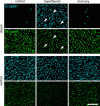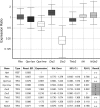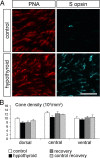Thyroid hormone controls cone opsin expression in the retina of adult rodents
- PMID: 21451022
- PMCID: PMC6622973
- DOI: 10.1523/JNEUROSCI.6181-10.2011
Thyroid hormone controls cone opsin expression in the retina of adult rodents
Abstract
Mammalian retinas display an astonishing diversity in the spatial arrangement of their spectral cone photoreceptors, probably in adaptation to different visual environments. Opsin expression patterns like the dorsoventral gradients of short-wave-sensitive (S) and middle- to long-wave-sensitive (M) cone opsin found in many species are established early in development and thought to be stable thereafter throughout life. In mouse early development, thyroid hormone (TH), through its receptor TRβ2, is an important regulator of cone spectral identity. However, the role of TH in the maintenance of the mature cone photoreceptor pattern is unclear. We here show that TH also controls adult cone opsin expression. Methimazole-induced suppression of serum TH in adult mice and rats yielded no changes in cone numbers but reversibly altered cone patterns by activating the expression of S-cone opsin and repressing the expression of M-cone opsin. Furthermore, treatment of athyroid Pax8(-/-) mice with TH restored a wild-type pattern of cone opsin expression that reverted back to the mutant S-opsin-dominated pattern after termination of treatment. No evidence for cone death or the generation of new cones from retinal progenitors was found in retinas that shifted opsin expression patterns. Together, this suggests that opsin expression in terminally differentiated mammalian cones remains subject to control by TH, a finding that is in contradiction to previous work and challenges the current view that opsin identity in mature mammalian cones is fixed by permanent gene silencing.
Figures









References
-
- Ahnelt PK, Kolb H. The mammalian photoreceptor mosaic-adaptive design. Prog Retin Eye Res. 2000;19:711–777. - PubMed
-
- Applebury ML, Antoch MP, Baxter LC, Chun LL, Falk JD, Farhangfar F, Kage K, Krzystolik MG, Lyass LA, Robbins JT. The murine cone photoreceptor: a single cone type expresses both S and M opsins with retinal spatial patterning. Neuron. 2000;27:513–523. - PubMed
-
- Applebury ML, Farhangfar F, Glösmann M, Hashimoto K, Kage K, Robbins JT, Shibusawa N, Wondisford FE, Zhang H. Transient expression of thyroid hormone nuclear receptor TRbeta2 sets S opsin patterning during cone photoreceptor genesis. Dev Dyn. 2007;236:1203–1212. - PubMed
-
- Bianco AC, Larsen PR. Cellular and structural biology of the deiodinases. Thyroid. 2005;15:777–786. - PubMed
-
- Cheng CL, Flamarique IN. Chromatic organization of cone photoreceptors in the retina of rainbow trout: single cones irreversibly switch from UV (SWS1) to blue (SWS2) light sensitive opsin during natural development. J Exp Biol. 2007;210:4123–4135. - PubMed
Publication types
MeSH terms
Substances
LinkOut - more resources
Full Text Sources
